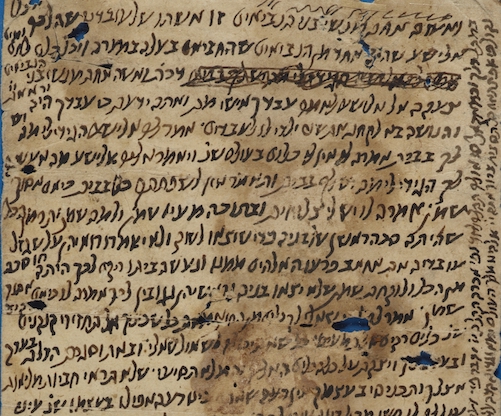Q&A Wednesday: Witches vs Theologians with Zvi Stampfer

Hi Zvi, which manuscript are you working on today?
I’m looking at a couple of Genizah manuscripts. In general, I’m now dealing with witches.
Are these magical texts or responsa about witches?
They’re theological texts, on the relations between witches and theologians – not personal relations but of an academic nature. Witchcraft and witches were challenging topics for Jewish rational theologians and they addressed it in their writings. The most challenging case was the biblical story of the Witch of Endor and King Saul.
What kinds of things worried the theologians?
The biblical story says King Saul tried to approach God, asking for His instructions for the upcoming war, but God did not answer him. So, he tried another way. He went to a necromancer woman and asked her to summon the prophet Samuel in a séance. They had an interesting conversation and the Bible describes it in realistic terms, as if it was really happening. This was a particularly challenging phenomenon for the rationalist theologians of the Middle Ages to explain – the apparent existence of black magic or something outside God's power.
How did they reconcile this story with their understanding of theology? Did different theologians reach different conclusions?
It seems that the sources of the Talmud and Midrash did not see it as a problem, but by the Middle Ages a rational theology (Mu'tazila) had developed, and it presented some difficulties. It seems that if you believe in what is written in the Bible you should accept that there are also 'other' powers in this world. But if you see yourself as a rationalist and a theologian, you have a problem. Genizah manuscripts preserve some of the interpretations put forward by Saadiah Gaon (already published by Shimon Shtober), and T-S Misc. 36.131 summarises the ideas of Samuel ben Hofni (published by Solomon Schechter).
How did Saadiah and Samuel ben Hofni interpret the issue? Did they differ?
Yes, they differed. Saadiah accepts the biblical story as really happening. He says that the necromancer woman actually brought up the prophet Samuel from the world of the dead and King Saul spoke to him, but that it was God's miracle, created especially for this special occasion. So, it was a true story on the one hand, but God's power on the other hand. Samuel ben Hofni, in contrast, says that she was a charlatan who knew how to trick people and tell them what they want to hear. There are some other approaches by Karaite scholars too, using ‘new’ and ‘modern’ approaches of the time – methods of interpretation that were also developed by Muslim theologians.
How far did these rationalist approaches permeate daily life?
As you know, there are many amulets in the Genizah, suggesting that the average person on the street in Medieval Fustat was less troubled by these issues than the theologians. We live in the same world – nothing has changed in that respect. People in trouble will seek the unnatural and will believe in what gives them comfort. Usually, they won't find comfort in rationalism, and it doesn't matter what theologians or philosophers have to say.
Last question – is this part of a project or are you working on this for fun (not that the two are mutually exclusive)?
It’s for fun.
Thanks Zvi – we’ll let you get back to the witches.

Add new comment